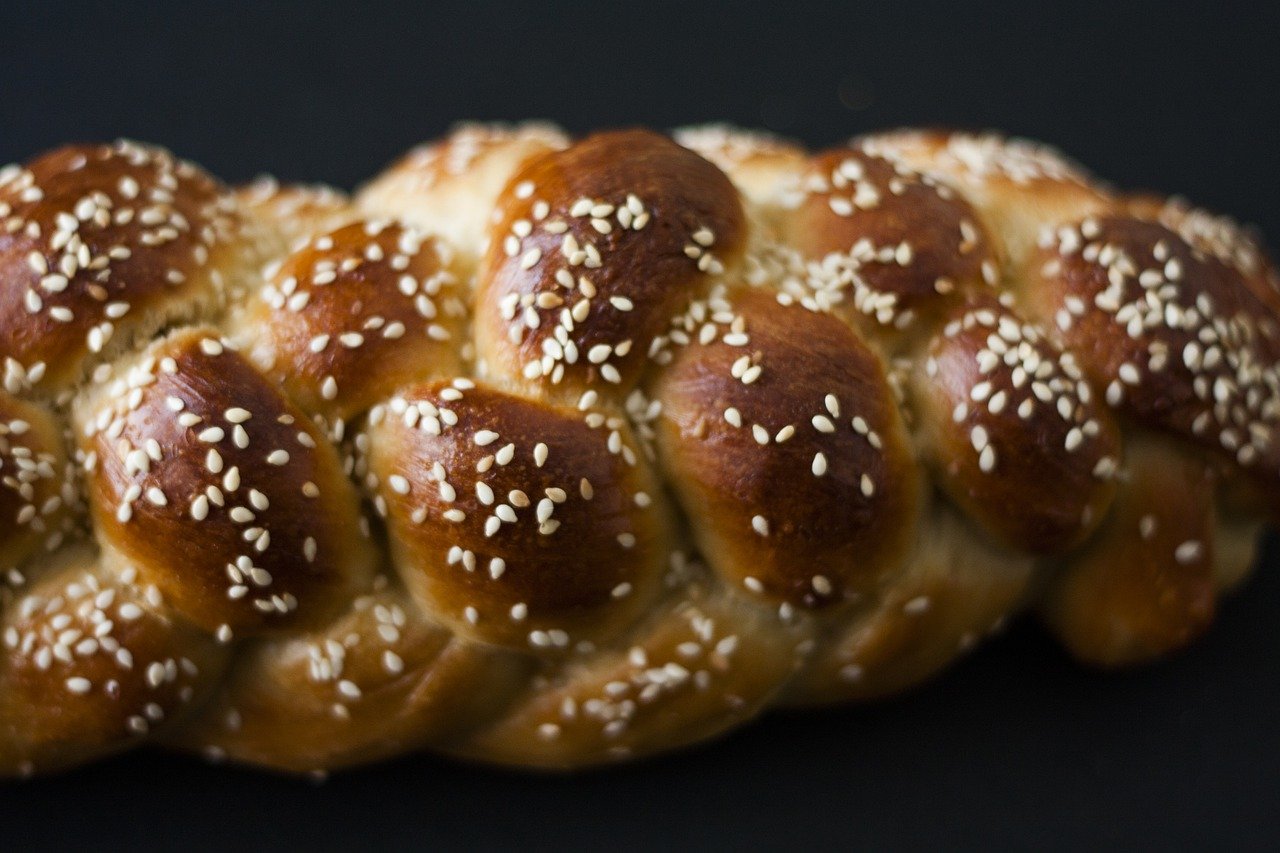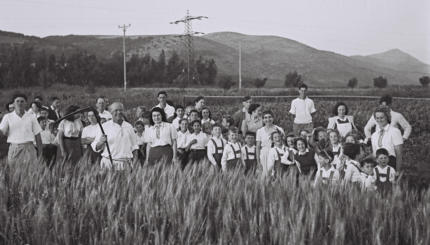How to “Take” Challah
A mitzvah that sets the braided bread apart.
For a variety of challah recipes, ranging from Honey Whole Wheat to Double Chocolate Chip to Gluten-Free, go to The Nosher, MyJewishLearning’s lively food blog. Or click here for a traditional challah recipe.
Baking bread satisfies in many ways. The meditative act of kneading, the nutty aroma of the baking loaf, and that first warm bite have won over bakers for millennia. With , the braided bread made for and festive holidays, you can add another layer to this experience by performing the of taking challah.
This mitzvah dates back to the time of the ancient Temple. In modern times, bakers — both professionals and amateurs — still separate challah when they make large batches of dough by removing a small piece before forming it into loaves. That piece is then burned and discarded. This is why on packages of challah and matzah the manufacturer prints the line “challah is taken.”
To try this at home, first determine if your recipe calls for a large enough amount of flour.
For batches of challah using more than 14 cups (3 lbs, 11 oz) for forming the dough and kneading, the baker “takes challah.” This means pinching off a piece of dough the size of a large olive. This small piece, like the bread, is called challah, and in these large batches the baker should say a blessing immediately before burning the challah that has been taken. This amount of dough may be too unwieldy to knead together or allow to rise all in one bowl. You may divide the dough into different bowls or knead balls of dough separately. If made all at once, it is still considered one batch, and one bit of separated challah–along with the blessing–covers all of it.
For batches of dough using between 14 and 10 cups of flour, one should separate the challah without a blessing. Any recipe calling for less than 10 cups of flour does not require the separating step at all.
There is one more condition for separating challah: The main liquid ingredient in the recipe should be water.
Separating and blessing the challah is a simple process. Form the dough, knead it, and allow it to rise in a large bowl (or two smaller bowls if necessary). Before forming the dough into loaves, separate that olive-sized piece and roll it into a ball. If the dough is divided into multiple bowls, join the pieces for a moment by laying them side-by-side on the counter so they touch.
Holding the piece of challah, say the blessing:
בָּרוּך אַתָּה יהוה אֱלֹהֵינוּ מֱלֶךְ הָעוֹלָם אֲשֶר קִדְּשֳנוּ בְּמִצְוֹתָיו וְצִוָנוּ לְהַפְרִישׁ חַלָּה מִן הָעִסָּה
Barukh ata Eloheinu melekh ha’olam asher kidshanu b’mitzvotav v’tzivanu l’hafreesh challah min ha’eesah.*
Blessed are You, Lord our God, Ruler of the Universe, who has sanctified us with commandments, and commanded us to separate challah.
Hold the piece of dough and say “harei zo challah” (This is challah).
Now you are ready to burn and discard the challah. The most common method is to wrap the dough in aluminum foil and then burn it in the bottom of the oven as it preheats or as the loaves bake. Some people burn the foil-wrapped piece of dough on the flame of a gas range. Others wrap the challah in a napkin or paper towel and discard it without burning.
Next, divide the dough into loaves, allow for a final rising, and bake. To get started, follow the recipe below. This calls for enough flour and the appropriate proportion of water to take challah and say the blessing.
*According to The Secret of Challah by Shira Wiener and Ayelet Yifrash, the phrase challah terumah (challah offering) is used in the tradition.
Ingredients
sesame and/or poppy seeds 1 cup olive oil 14-15 cups (about 4 lbs) all-purpose or bread flour, plus another cup for flouring the kneading surface 1/4 cup dry yeast (5 packets) 4 cups luke warm water 1 cup sugar or 3/4 cup honey 5 large eggs 2 Tablespoons salt
Directions
In a medium bowl, combine yeast and water and a sprinkling of the sugar or a few drops of honey. Let sit for about 10 minutes. Meanwhile, in a large mixing bowl, beat the eggs and reserve 3 Tablespoons for the egg wash. Mix in 1 Tablespoon water to make the wash and store it in the refrigerator. Also prepare a clean counter space with a sprinkle of flour for kneading.
When the yeast mixture begins to bubble, add the mixture to the eggs not reserved for the wash, along with the rest of the sugar or honey, salt, and oil. Sprinkle in 2 cups of flour and work it in with a whisk. Continue to add flour, 1-2 cups at a time, and continue to mix. When the dough is too thick to mix with the whisk, turn it out onto the floured counter top and continue adding flour and kneading it in with your hands.
When dough is no longer sticky and forms a firm (but soft) ball, continue to knead for 10 minutes.
Clean the large bowl that you used to mix the dough, or prepare two medium bowls. The bowl space should be large enough that the dough fills it no more than halfway. Oil the sides of the bowl(s). Form the dough into one or two balls. Place the dough in the bowl(s), with the seam side of the ball facing down. Cover the bowl with plastic wrap or wax paper and let it sit in a warm place for 1 1/2-2 hours, or until the dough has doubled in bulk.
Now you are ready to separate challah. If the dough is in two separate bowls, put the pieces of dough side-by-side on the counter so they touch. Pull off the olive-sized scrap of dough and say the blessing. Wrap the small piece of dough in aluminum foil and burn it in the oven or on the stovetop (if using a gas range). Be careful that it doesn’t catch fire! Or wrap the dough in a napkin or paper towel, then discard it.
When this is finished, divide the remaining dough into 6 pieces. Each of these pieces will form one loaf. To shape the challah, try the braiding techniques in this recipe for the classic look. Many bakers use different shapes in honor of various holidays, such as a round challah for Rosh Hashanah, the new calendar year. The Rosh Hashanah challah can be formed by rolling the dough into one long strand and then coiling it into a spiral.
When the loaves are ready, place them on an oiled baking sheet at least 2 inches apart. Allow to rise for 1 hour or until doubled in size again.
While the dough completes its second rise, reheat the oven to 350F. Brush the tops of the loaves with the reserved egg wash and sprinkle with seeds, if desired.
Bake loaves for 35-40 minutes, or until a knock on the base of the loaf produces a hollow sound.
To store leftover challah, place cooled loaves in zip-top bags and keep in the refrigerator or freezer. To serve, bring up to room temperature, wrap in aluminum foil, and warm in a 350F oven for 10-15 minutes.



